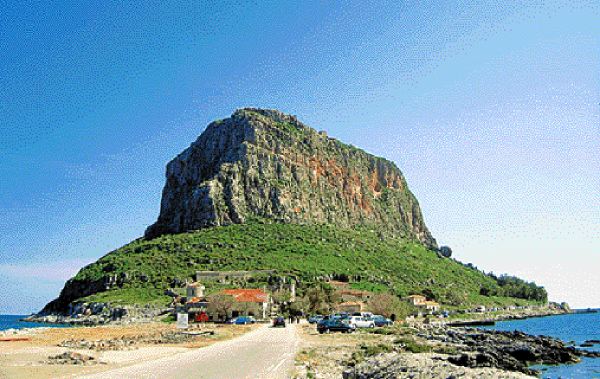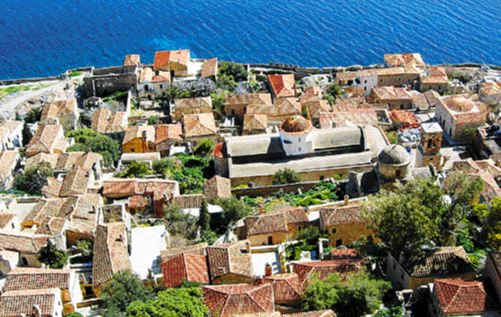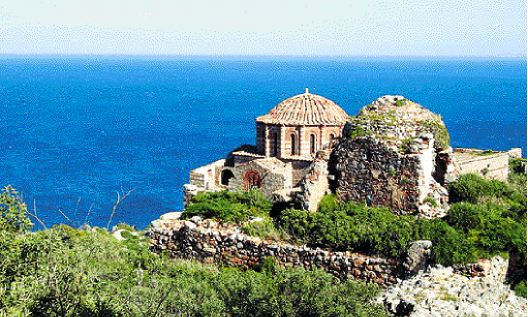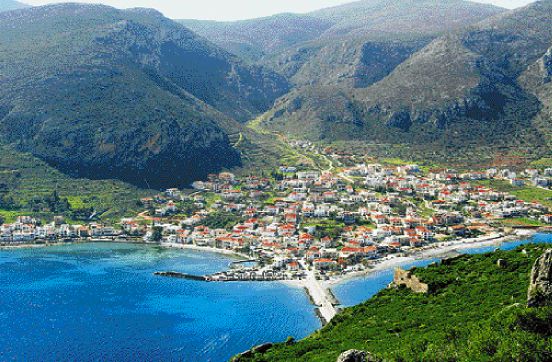 |
||
|
The Mediaeval Allure of Monemvasia
|
||
|
A popular destination among Greeks and foreigners alike, the old town is a picture-perfect backdrop to leisurely walks, atmospheric weddings and even tastings of the local Monemvasian wines By Stella Sevastopoulou
|
 Monemvasia's rock as seen from a distance |
|
| shrines that are similarly perched on rocks that break out of the sea's calm. But Monemvasia is undoubtedly unique because as a mediaeval fortress in Greece it benefits from the light of the Mediterranean sun and, unlike some other tourist attractions in this country, it is relatively unspoilt by tourism's uglier, overrun side. This fortified mediaeval town, built on a dramatic eruption of reddish-brown rock, surrounded by indigo sea, offers visitors a quieter vacation option, with authentic character, although the truth is that it has been getting all the more popular over the past few years. Ideal either for a winter getaway, with the 'rock' getting 'atmospheric' in the grey tones of this time of year, or for a beautiful spring break, full of walks, great meals, poppies and daisies. During the summer months you can enjoy this region of the Peloponnese's Laconia and also enjoy the beaches. Of course, climbing those steps to the upper level of the mediaeval town might be given a miss in the heat. |
||
Europe has realised the importance of its chateaux, mediaeval castles and stately homes by keeping them in tip-top condition and making them accessible to the public. Here in Greece, there are still quite a few historical buildings and sites that need to be given the proper attention in order to become 'site attractions' to their full potential, rather than sad examples of deteriorating culture. The Tatoi - with all its beautiful artifacts (which were in the news recently) - could have been a museum by now, |
 The fortified mediaeval town sits on a dramatic reddish-brown rock, surrounded by indigo sea |
|
| for example. In terms of mediaeval heritage, many would argue that Rhodes' Old Town - the oldest inhabited mediaeval town in Europe - is probably the best example of how tourism and cultural heritage can join forces in the best possible way, but there are other places heading in the same direction. Monemvasia might be a smaller site, but it has a lot of potential for tourism - something which is growing in the region. Back in the 14th century, Monemvasia's geographical location aided this town to gain importance as a commercial centre and as a seaport, serving as the Greek Byzantine capital. Nowadays, its location at the tip of the Peloponnese's first leg, with islands such as Elafonisos and Kythera within easy reach, is attracting all the more visitors, but also foreign residents. "Not much has changed in Monemvasia in recent history, apart from the greater development of the fortified town", explains Athens-based businessman Konstantinos Doukas (chairman of Doukas supermarkets) to the Athens News. His family's roots have not been severed from their birth-place of Monemvasia, seeing as they are active here both in terms of wine-making and in terms of providing quality tourist accommodation at Villa Doukas. He explains how "in the sixties you could buy one of the half-ruined houses in the mediaeval town for 20,000 drachmas (around 80 euros). Nowadays, they sell for 100 million drachmas (300,000 euros) for a building which occupies around 80-100 square metres. Of course, you have to consider that back in the sixties an average wage was around 1,000 drachmas, so you were talking about 20 wages." Nowadays, you'll need quite a few more! Many Italians, Germans and French started buying property within the fortified town in the eighties and have renovated the buildings, sticking to the guidelines of the Archaeological Society and thus maintaining - or rather enhancing - the site's characteristics. Apparently, throughout history the kastro - as the fortified town is called by the locals - was always inhabited. |
||
My first visit to Monemvasia was to a summer wedding there a few years back, which took place in the mediaeval town. Thing is it wasn't the only wedding taking place there that day, and the experience was somewhat surreal as we walked along the narrow cobbled streets - high heels getting caught in the cracks between the stones, which have been 'polished' by time - in order to find the right church and bride. In its Byzantine heyday, there were 40 churches in the lower town. Nowadays, there are three |
 The exquisite Agia Sophia in the upper town |
|
| in full 'service' - the cathedral, or Mitropolis (dedicated to Christ in Chains), Agios Pavlos, and Hrisafitissa - plus the exquisite Agia Sophia in the upper town. One cannot argue that such a place is picture-perfect for weddings, hence its popularity. My recent visit could be categorised as a 'family outing' and, indeed, this is one place where families are welcomed, and where young and old will have a good time. Kids will enjoy exploring the mediaeval town just as much as the parents, and there are plenty of cafes, restaurants and tourist shops in the lower section of the town to satisfy thirst and hunger. No signs of an ancient civilisation have been found here, probably because of the difficulty of finding fresh water on the rock, while on the opposite shore traces of a Mycenaean settlement have been found. The town was probably built in the 6th century AD (around 583) by Byzantine Greeks seeking refuge from the Slavic and Avaric invaders of Greece. For 700 years it remained under Byzantine rule - only briefly within that period being ruled by Franks. Monemvasia was a seaport in a strategic position between East (Constantinople and the Levant) and West (Italy and Europe) in the Middle Ages. In the 12th century Monemvasia withstood attacks by the Arabs and the Normans. In 1249, it was taken over by the Frankish crusaders, under the rule of Guillaume de Villehardouin - the last Villehardouin prince of Achaea and overlord of the Venetian Duchy of the Archipelago and other Venetian territories in the Aegean Sea. It was the last region of Greece that had refused to surrender to them and only did so after a three-year siege. In 1259 the castle of Monemvasia together with those of Mystra and Mani was given back to the Byzantines, in return for setting free Villehardouin, who had been captured in the battle of Pelagonia. Under the rule of Byzantine Emperor Michael VIII Paleologus, Monemvasia became an important maritime and commercial centre, especially famous for its wine called Malvasia, which even Shakespeare has referred to as "Malmsey". Indeed it is mentioned in three of his plays: Love's Labour's Lost, Henry IV and Richard III. In the last, it is used as a means to kill Richard's brother, the Duke of Clarence: his assassins think of drowning him in a large cask (butt) of the sweet stuff. |
||
| The town was probably built in the 6th century AD (around 583) by Byzantine Greeks seeking refuge from the Slavic and Avaric invaders of Greece. For 700 years it remained under Byzantine rule - only briefly within that period being ruled by Franks. Monemvasia was a seaport in a strategic position between East (Constantinople and the Levant) and West (Italy and Europe) in the Middle Ages. In the 12th century Monemvasia withstood attacks by the Arabs and the Normans. In 1249, it was taken over by the Frankish crusaders, under the rule of Guillaume de Villehardouin - the last Villehardouin |
 A bridge joins Monemvasia with the village of Gefyra opposite
|
|
| prince of Achaea and overlord of the Venetian Duchy of the Archipelago and other Venetian territories in the Aegean Sea. It was the last region of Greece that had refused to surrender to them and only did so after a three-year siege. In 1259 the castle of Monemvasia together with those of Mystra and Mani was given back to the Byzantines, in return for setting free Villehardouin, who had been captured in the battle of Pelagonia. Under the rule of Byzantine Emperor Michael VIII Paleologus, Monemvasia became an important maritime and commercial centre, especially famous for its wine called Malvasia, which even Shakespeare has referred to as "Malmsey". Indeed it is mentioned in three of his plays: Love's Labour's Lost, Henry IV and Richard III. In the last, it is used as a means to kill Richard's brother, the Duke of Clarence: his assassins think of drowning him in a large cask (butt) of the sweet stuff. In recent history, the wine tradition of Monemvasia has witnessed a great decline, although there are new efforts taking place, such as those of the Doukas Estate - the only vineyard in the area that is producing biological wines, from mavrofilero and kydonitsa grapes. The latter variety had disappeared from the area, and has now been 'returned' via the estate's efforts to breathe new life into the wine-making tradition here. Situated in the Zarakas region, past the natural Fjord of Yeraka and the vicinity of Lambokambo, this vineyard can be visited by the public in the summer months and during trigos (grape-harvesting season, which is around the end of August, tel 2732-051371). There is also a church on the estate dedicated to Agios Trifonas, protector of those that cultivate the vine, and Agios Savvas. The second Byzantine period of Monemvasia ended in 1460, when in order to defend itself against the Ottoman empire, Monemvasia first allied with Catalonian troops, then placed itself under the authority of the pope in Rome, followed by a Venetian rule from 1464 to 1540, before it finally surrendered to the Turks, remaining with them until 1690. Then Venetian troops took it back again, and held on to the town until 1715, when again the Turks took over. The 'tug-of-war' ended for good in 1821, when Monemvasia was the first fortification that the Turks surrendered during the Greek War of Independence. During the 19th century and first half of the 20th century, Monemvasia remained a small country town with few inhabitants, many having emigrated abroad, or moved to Athens. However, over the last twenty years, the rock is now witnessing a new leash of life, seeing as the ruins there are again becoming buildings: apart from the private homes, this time hotels, shops, restaurants, bars and cafes are also there, in the service of tourism. There are plenty of things to explore both in Monemvasia and around. Once past the bridge that joins the rock with the mainland, you walk towards the fortress' only entrance - which is from where Monemvasia gets its name (moni emvasi means single entrance). Once you have entered the fortified town, a stroll down the main cobbled street leads to the main square, where you will find the cathedral, or 'Mitropolis' of Christ in Chains (Elkomenou Christou), which is named after an icon which, however, was stolen and taken to Constantinople during the reign of Byzantine Emperor Isaac Angelos. The church was founded in the 12th century, although its present state suggests it was completed in 1691. Opposite this church is the domed church of Agios Pavlos, which had been transformed into a mosque by the Turks and now serves as a museum. During Ottoman reign, the Christian cathedral and the mosque were functioning side by side. Past the square and moving towards the sea, you meet the church Hrisafitissa. Here you also get a good view of the upper town, which is quite a hike to get to, but worth the effort, because the Agia Sophia up there is a unique church, built in the 13th century by Andronikus II. Among the many ruins of the upper town, you will come across a vast cistern which was used to ensure water supply during a siege. A trip to nearby Yerakas is also worthwhile, as this beautiful natural fjord comes complete with great fish taverns. And for a taste of true Monemvasian delights, try a visit to the village of Agios Ioannis, where you will find a taverna named Athas. Here you can sample some saitia - a thin spinach pie, or gogles, homemade macaroni smothered in butter and cheese. In the village of Gefyra, which is situated by the bridge that joins Monemvasia to the mainland, you will also be able to try some fish dishes, but if you head on down the seafront, towards the end of the line of tavernas and cafes, you will find the Votsalo, a taverna where Kyria Stavroula is in charge and makes sure the food is homemade and wholesome. A trip to the Richia Museum of Folklore (situated in Richia, 25km from Monemvasia), or to the Monastery of the Annunciation of the Virgin and Agios Georgios, near the village of Yerakas, can also be planned. For rock climbers, there are caves in the vicinity to be explored, such as that of Kastania (south of Monemvasia), and the Vri Cave, north of Monemvasia. * How to get there (Telephone Nikos Kapeleris for more details at 27320-61181) |
||
|
|
||
(Posting date 26 March 2007) HCS readers can view other excellent articles by the Athens News writers and staff in many sections of our extensive, permanent archives, especially our News & Issues, Travel in Greece, Business, and Food, Recipes & Garden sections at the URL http://www.helleniccomserve.com./contents.html
All articles of Athens News appearing on HCS have been reprinted with permission. |
||
|
||
|
2000 © Hellenic Communication Service, L.L.C. All Rights Reserved. http://www.HellenicComServe.com |
||

